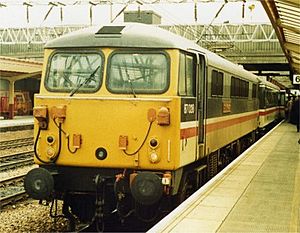British Rail Class 87 facts for kids
Quick facts for kids British Rail Class 87 |
|
 |
|
| No.87028 Lord President in InterCity livery at Crewe station in 1988. | |
| Power type | Electric |
|---|---|
| Builder | BREL Crewe Works |
| Build date | 1973–1975 |
| Total production | 36 |
| Configuration | Bo-Bo |
| UIC classification | Bo'Bo' |
| Wheel diameter | 3 ft 9+1⁄4 in (1.149 m) |
| Locomotive weight | 83.30 long tons (84.64 t) |
| Electric system(s) | 25 kV AC |
| Current collection method | Pantograph |
| Traction motors | 1,250 hp (930 kW) GEC G412AZ, 4 off |
| Top speed | 110 mph (180 km/h) |
| Power output | 5,000 bhp (3,730 kW) |
| Tractive effort | 58,000 lbf (258 kN) |
| Train heating | Electric Train Heating |
| Train brakes | Air |
| Career | British Rail, Virgin Trains, GBRf, Cotswold Rail, Bulgarian State Railways |
| Number | 87001–87035, 87101 |
| Axle load class | Route availability 6 |
The Class 87 is a powerful electric locomotive from British Rail. These trains were built between 1973 and 1975. A total of 36 Class 87 locomotives were made. They were designed to pull passenger trains. Their main route was the West Coast Main Line (WCML).
For many years, the Class 87s were the most important electric trains for British Rail. This changed in the late 1980s. Newer Class 90 trains began to take over. When the British railway system changed ownership, nearly all Class 87s went to Virgin Trains. They kept working until new Pendolino trains arrived. After that, the Class 87s were either sent to other train companies or stopped being used.
The very last Class 87 train used in the UK stopped service on 31 December 2007. Today, most of these locomotives have been sold. They are now used in Bulgaria.
Images for kids
-
The Class 90 s were a modernised derivative of the Class 87s, built in the late-1980s. They were originally designated as the Class 87/2
-
87006 "City of Glasgow" at Glasgow Central in 1983
-
87003 Patriot at Manchester Piccadilly in InterCity livery in 1992
-
87001 on static display at the National Railway Museum









